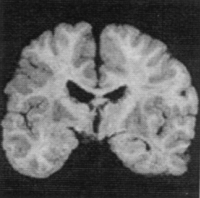Wilson's disease is a rare autosomal recessive disorder of copper transport, resulting in copper accumulation and toxicity in the liver and the brain. Liver disease is the most common symptom in children, neurological disease is the most common in adults. The cornea of eye can also be affected, the kayser Feischer ring is a deep copper-colored ring at the periphery of the cornea and is thought to represent copper deposits.
The gene for Wilson disease (ATP7B) was mapped to chromosome 13. The gene sequence was found to be similar to sections of the gene defective in menkes disease, another disease caused by defects in copper transport. The similar sequences code for copper binding regions, which are part of a transmembrane bronk pump called a P-type ATpase that is very similar to menkes disease protein.
A homology to the human ATP7B gene has been mapped to mouse chromosome 8, and an authentic model of the human disease in rat is also available (called the long Evans Cinnamon (LEC) (rat). These systems will be useful for studying copper transport and liver pathophysiology, and should help in the development of a therapy for Wilson's disease.
 | Fig. 49: In Wilson's disease, toxic level of copper accumulate and damage many tissues and organs, including the basal ganglia of the brain [Image credit: Kevin Roth and Robert Schmidt, Washington University, St. Louis, MO, USA.] |
 Prof. Dr. Sohan Raj Tater
Prof. Dr. Sohan Raj Tater
 Doctoral Thesis, JVBU
Doctoral Thesis, JVBU